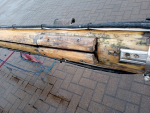DangerousPirate
Well-Known Member
Hi, with my new boat (nicholson 30) I noticed it's a pain in the after to raise, lower and flake the main. Especially alone. It was a HUGE effort. And when I prepared the boat for on the mooring I didn't get to flake the sail properly to fit in the sailcover again, gave up after half an hour (I had places to be) and just rolled the main up and threw it below deck. Jeez.
I'd like sail slugs on it and just wanted a little info on that. What's the best system? I will be handling the big boy on my own for presumably 99% of the time.
I'd like sail slugs on it and just wanted a little info on that. What's the best system? I will be handling the big boy on my own for presumably 99% of the time.

